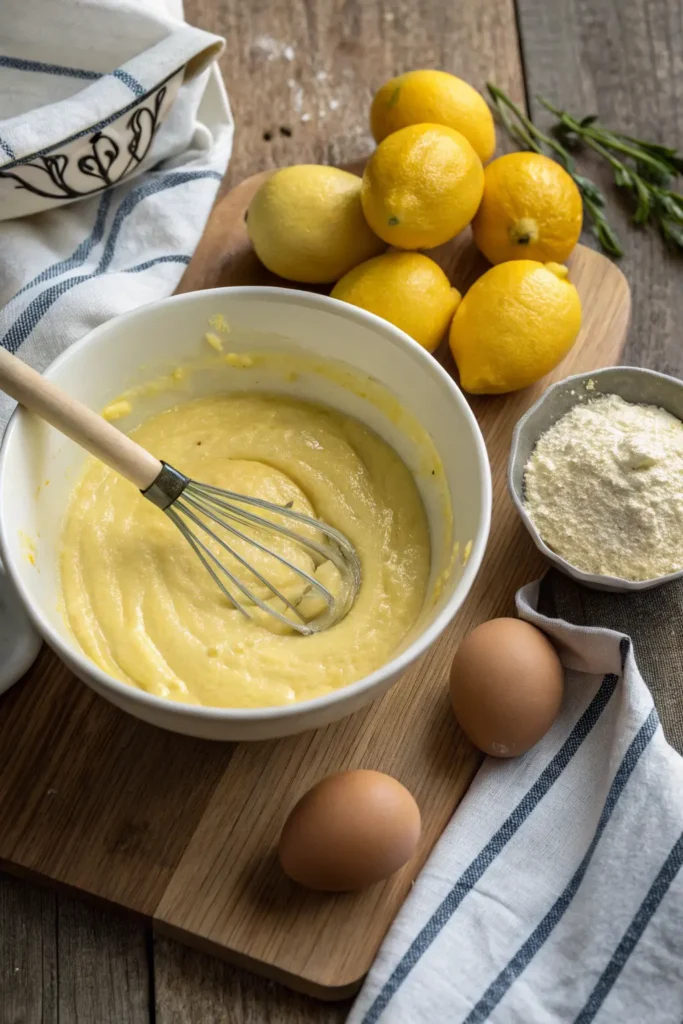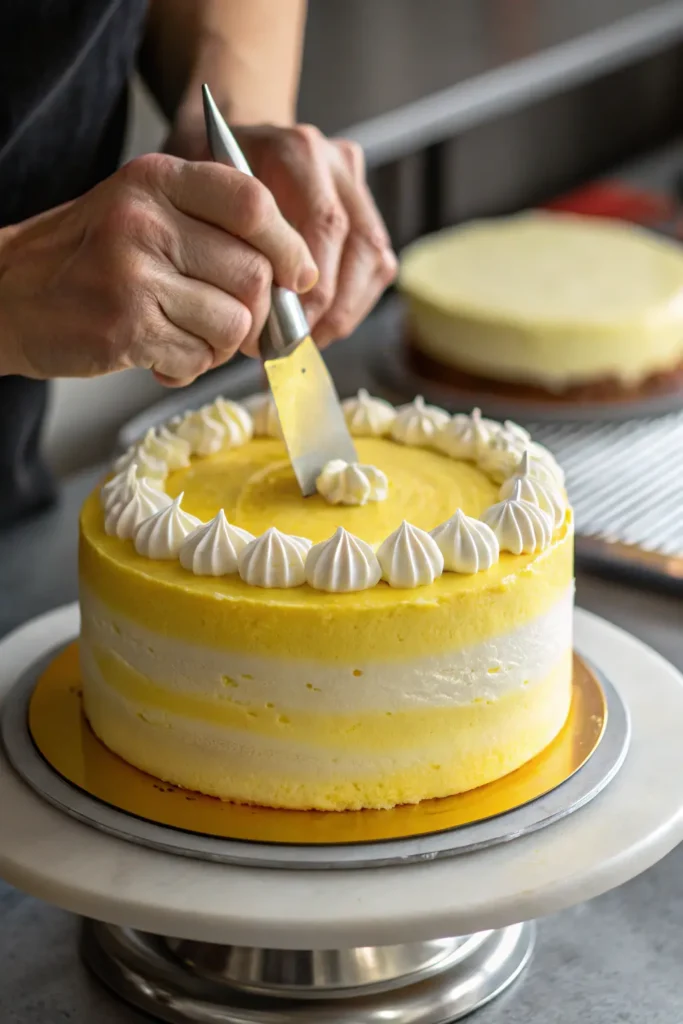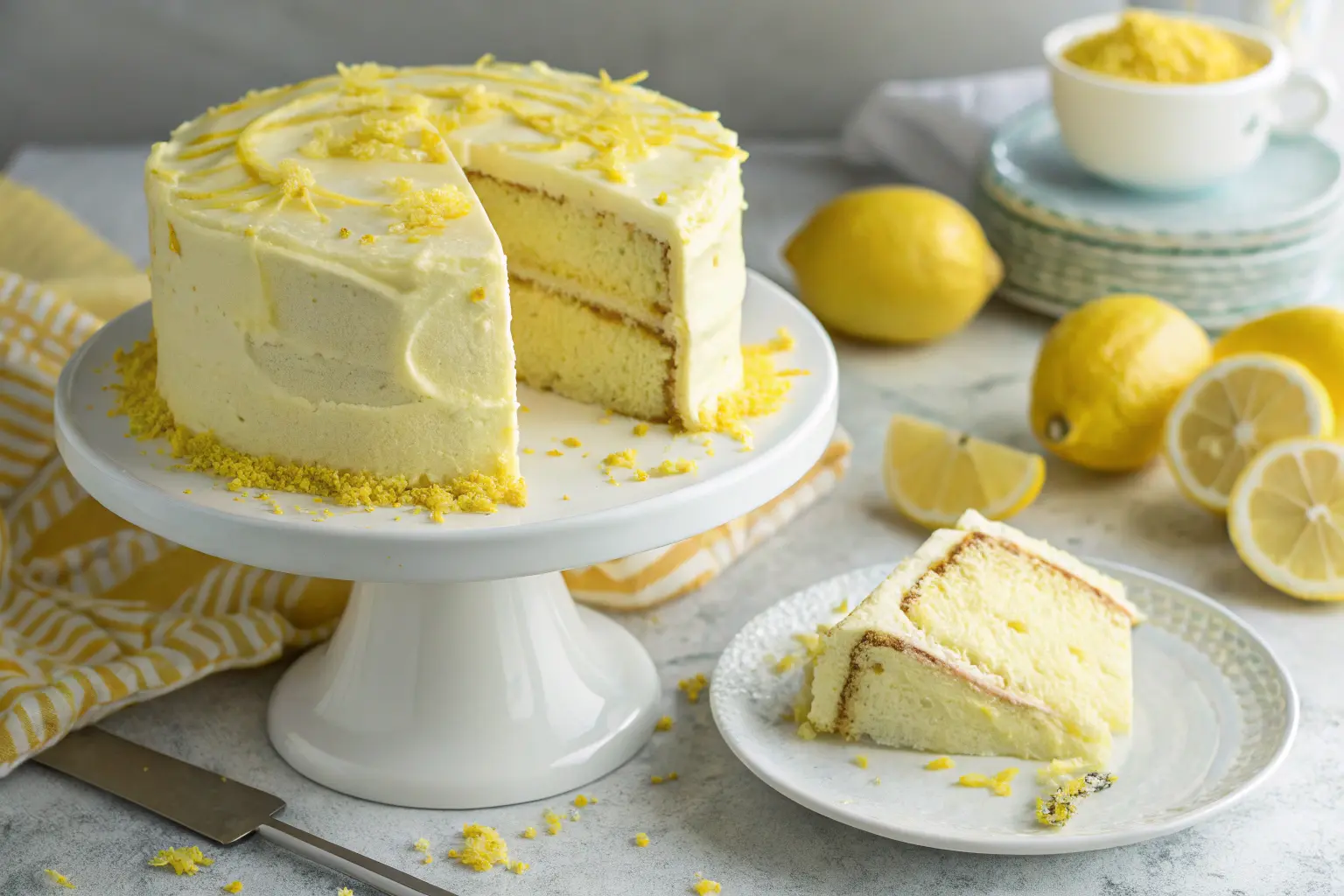There’s something magical about the perfect slice of lemon velvet cake with lemon cream cheese frosting. With its soft, velvety crumb, bright citrus zing, and creamy, tangy frosting, this cake is a showstopper at every event — whether it’s a birthday, brunch, or just a weekend craving. In this article, we’ll dive deep into what makes this citrus cake so irresistible.
Discover with us this easy and delicious recipe: Almond Joy Protein Balls
You’ll discover not only how to bake a flawless lemon velvet cake, but also how to whip up the dreamiest cream cheese frosting. We’ll cover key ingredients, baking techniques, decorating tips, storage advice, and even allergy-friendly variations. From prep to presentation, you’re getting a full masterclass.
Learn how to balance tart and sweet flavors, keep the crumb moist, and layer like a pro. And yes, we’ll answer those burning questions from Google’s “People Also Ask” and give you plenty of clever ideas for giving your lemon cake a personal twist.
Discover with us this easy and delicious recipe: recipesfreesh
What is Lemon Velvet Cake With Lemon Cream Cheese Frosting?
What Makes Lemon Velvet Cake Different from Regular Lemon Cake?
Let’s get this straight — not all lemon cakes are created equal. Lemon velvet cake with lemon cream cheese frosting isn’t your average zesty dessert. What sets it apart is the texture. It’s not just soft — it’s silky, tender, and almost melts in your mouth. That’s thanks to a carefully balanced mix of cake flour, buttermilk, and oil, which makes the crumb lighter and more luxurious than typical butter-based lemon cakes.
Regular lemon cakes tend to be more dense and often lean heavily on butter. Velvet cakes, however, use a blend of acidic ingredients (like buttermilk and lemon juice) combined with baking soda or powder. This chemical combo creates tiny air pockets throughout the batter — and voilà, a velvet-like texture.
The Unique Velvety Texture
- Buttermilk adds moisture and subtle tang.
- Oil replaces butter to reduce density and boost softness.
- Cake flour has less protein than all-purpose, so it creates a finer crumb.
If you’ve never tried lemon in a velvet-style cake, prepare to be wowed. It’s fluffier, brighter, and less greasy than many traditional lemon cakes.
Difference in Ingredients and Preparation
The ingredient list for a lemon velvet cake is quite similar to red velvet — minus the cocoa, of course. It includes:
- Cake flour instead of all-purpose
- Vegetable oil rather than butter
- Buttermilk for tenderizing
- Vinegar or lemon juice for acidity
- A bit of baking soda to lift the batter
Unlike a basic lemon pound cake, where creaming butter and sugar is the first step, this version skips that in favor of mixing wet and dry ingredients separately. The result? Less risk of overmixing and more consistent moisture throughout the cake.
The Origins and Rise in Popularity
While the exact origins of lemon velvet cake are a bit murky, its roots trace back to the American South, where velvet cakes of all kinds have been baked for generations. First came the infamous red velvet, then bakers began experimenting with other flavors.
In recent years, lemon velvet has exploded in popularity. Why? It’s a perfect marriage of bright citrus flavor and classic Southern comfort food. Add to that the growing love for nostalgic homemade bakes with a modern twist, and this cake’s appeal is easy to understand.
Southern Roots and Culinary Evolution
Velvet cakes were once considered “fancy” desserts served during the holidays or at weddings. But as baking became more accessible, especially with social media fueling food trends, home bakers began reinventing velvet cakes in all sorts of flavors — lemon being one of the most beloved.
Why This Cake is Trending Now
- It’s visually stunning with its sunny yellow hue.
- It photographs beautifully for social media posts.
- The balance of tangy lemon and sweet cream cheese frosting is irresistible.
- It fits every season — light enough for spring, but indulgent enough for winter celebrations.
With so much going for it, it’s no surprise that lemon velvet cake with lemon cream cheese frosting is now a staple in both bakeries and home kitchens.
Ingredients Breakdown and Their Role in the Cake
Understanding each ingredient in a lemon velvet cake with lemon cream cheese frosting is key to baking it successfully. Each one plays a specific role in creating that dreamy, melt-in-your-mouth texture and zesty flavor. Whether you’re a seasoned baker or trying this for the first time, knowing why these ingredients matter can make all the difference.
Essential Ingredients for the Lemon Velvet Cake Base
Let’s start with the building blocks of the cake itself. What makes the texture so velvety and the flavor so citrus-forward?
Key Items: Flour, Buttermilk, Lemon Zest, Oil
- Cake flour is lighter and softer than all-purpose flour. It gives the cake its signature soft crumb and delicate texture. If you only have all-purpose, try replacing 2 tablespoons of every cup with cornstarch for a close match.
- Buttermilk adds both tang and moisture. Its acidity reacts with baking soda to help the cake rise and stay fluffy. No buttermilk? Add a tablespoon of lemon juice or vinegar to a cup of milk.
- Lemon zest packs more lemon punch than juice alone. It gives the batter intense citrus aroma and a flavor that cuts through the sweetness.
- Vegetable oil is used instead of butter to keep the cake moist and tender even after refrigeration. This is a big reason why lemon velvet cake doesn’t dry out quickly.
These ingredients work together to create a balance of bright citrus notes with a soft, cloud-like crumb — the essence of velvet.
Importance of Cake Flour for the Soft Texture
Unlike all-purpose flour, cake flour has a lower protein content. This means less gluten is formed during mixing, which leads to:
- A finer, softer texture
- Less chewiness
- A lighter crumb that still holds moisture
For an ultra-soft result, sift the cake flour before adding it to your batter.
The Cream Cheese Frosting: Rich Yet Refreshing
Now, let’s talk frosting. The lemon cream cheese frosting is where tang meets sweet in the best possible way.
Balancing Tangy Cream Cheese and Fresh Lemon Juice
Cream cheese has a bold, slightly tangy flavor that complements the sweetness of powdered sugar and the sharp zing of lemon. But to avoid a frosting that’s either too sweet or too sour, it’s important to:
- Use full-fat cream cheese for richness
- Add fresh lemon juice and zest gradually, tasting as you go
- Balance sweetness with a pinch of salt or a touch of vanilla
This harmony of flavors makes the frosting a true show-stealer and perfect companion to the cake’s vibrant base.
Choosing the Right Cream Cheese and Sugar Type
For a silky, spreadable texture:
- Go for block-style cream cheese, not the whipped kind
- Use powdered sugar, not granulated — it dissolves smoothly and avoids a gritty feel
Once whipped, this frosting should hold its shape but still glide easily across each layer of cake.
Step-by-Step Guide to Making Lemon Velvet Cake

Now that you’ve got your ingredients lined up, it’s time to roll up those sleeves. Making a lemon velvet cake with lemon cream cheese frosting isn’t hard, but following the right method is key to pulling off that signature softness and flavor.
Preparing the Batter for a Perfect Texture
Before you even turn on the oven, prep is everything. Make sure your ingredients are at room temperature — especially the eggs, buttermilk, and cream cheese. This helps everything mix evenly and keeps your batter from curdling.
How to Cream Ingredients Without Overmixing
Unlike traditional cakes, velvet cake doesn’t need heavy creaming of butter and sugar. Instead:
- Mix your dry ingredients in one bowl (cake flour, baking soda, salt).
- In another, whisk your oil, sugar, eggs, lemon zest, and buttermilk.
- Slowly combine the two mixtures, folding just until blended.
Don’t overmix — this is where many go wrong. Stirring too much can develop too much gluten and make your cake chewy, not soft.
Achieving the Right Batter Consistency
The batter should be:
- Smooth and silky
- Slightly thick but pourable
- Pale yellow with visible flecks of zest
If it’s too runny, double-check your measurements. Too thick? Add a tablespoon of lemon juice or a splash of buttermilk.
Baking the Cake to Moist Perfection
Here’s where things really start to smell amazing. Preheat your oven to 350°F (175°C) and prepare your pans by greasing and flouring or using parchment paper rounds.
Tips on Oven Temperature and Timing
- Use light-colored pans to avoid over-browning.
- Bake in the middle rack for even heat.
- Start checking for doneness around the 25-minute mark.
A fully baked lemon velvet cake will have:
- A light golden top
- Slight spring when pressed
- A clean toothpick when inserted
Testing for Doneness and Cooling Methods
Pull your cake when it’s just done — overbaking is the enemy of moistness. Let it rest in the pan for 10 minutes, then gently turn it out onto a wire rack.
Let the layers cool completely before frosting. If you frost too soon, the heat will melt your cream cheese mixture and create a sloppy mess.
Crafting the Perfect Lemon Cream Cheese Frosting
No lemon velvet cake with lemon cream cheese frosting is complete without its silky, citrus-kissed crown. This frosting brings just the right amount of tang and creaminess to balance the soft, sweet cake layers. But getting the texture and flavor just right takes more than just mixing a few ingredients.
Let’s break down the secrets to making a fluffy, zesty, and smooth lemon cream cheese frosting that spreads like a dream and tastes even better.
Mixing the Ingredients for Creamy Consistency
First things first — temperature matters. Both the butter and cream cheese need to be softened to room temperature. Cold ingredients won’t blend smoothly, and melted ones will lead to a runny mess.
Best Practices for Room Temperature Ingredients
- Leave cream cheese and butter out for about an hour before starting.
- If you’re in a rush, cut them into cubes to warm faster.
- Avoid microwaving — it leads to uneven softening.
Once softened, beat the cream cheese and butter together until light and fluffy. Use a stand mixer or hand mixer on medium speed — don’t do this by hand, or you’ll miss out on the airy texture.
After whipping, gradually add powdered sugar, one cup at a time, then follow with fresh lemon juice and a little zest. This method keeps your frosting smooth and lump-free.
Flavor Enhancement Techniques
There’s more to this frosting than just tang and sweetness. You can fine-tune the flavor to your liking with a few easy additions.
Adding Zest vs. Lemon Juice
Both bring lemon flavor, but they work differently:
- Zest adds intense citrus aroma and richness without watering down your frosting.
- Juice brightens the flavor but can thin the texture if overused.
Try starting with 1 tablespoon of lemon juice and 1 teaspoon of zest. You can always add more to punch it up.
Optional Add-Ins: Vanilla, Honey, or Zest Blends
Want to make it extra special?
- A dash of pure vanilla extract adds warmth and balances the tart notes.
- A small spoon of honey can bring a gentle floral sweetness.
- Mix in orange or lime zest for a more complex citrus profile.
This frosting pairs beautifully with other citrus desserts too — think citrus cupcakes, key lime cakes, or even a grapefruit torte.
Assembly and Layering Tips for a Showstopper Cake

Now that your cake is cooled and your frosting is whipped to perfection, it’s time to put it all together. Assembling a lemon velvet cake with lemon cream cheese frosting takes a little patience — but with the right techniques, your final result will look as good as it tastes.
Cutting and Layering the Cake Evenly
Even layers make for a professional-looking cake and ensure a balanced bite every time. Don’t worry — you don’t need fancy tools to pull this off.
Tools to Use for Best Results
- A long, serrated knife or cake leveler
- Cake turntable (optional but helpful)
- Offset spatula for spreading frosting
Start by leveling the top of each cake layer so they sit flat. Use a light sawing motion and take your time — rushing this step can tear the sponge.
Once leveled, use a bit of frosting to “glue” the bottom layer to your cake board or plate. This helps keep everything in place while you stack.
How to Prevent Crumb Disasters
Crumbs are the enemy of clean frosting. To keep them under control:
- Use a thin layer of frosting (called a crumb coat) to seal the cake.
- Chill the cake for 15–30 minutes after the crumb coat to firm it up.
- Apply the final frosting layer using long, smooth strokes.
This step is especially helpful with velvet cakes since they’re so tender and can shed crumbs easily.
Frosting Like a Pro: Final Touches
The finish is where your cake goes from homemade to bakery-worthy.
Crumb-Coating the Cake
Here’s a simple technique:
- Spread a thin layer of frosting all over the cake.
- Don’t worry about it being perfect — this coat catches crumbs.
- Chill until set.
After the crumb coat is chilled, add your final thick layer. This one should be smooth and flawless.
Smooth Finish Techniques and Piping Options
For a polished look:
- Dip your spatula in hot water and wipe it dry before smoothing the frosting.
- Use a bench scraper for even edges.
Want to add a little flair? Use a piping bag to make rosettes or borders around the top. Add lemon twists, candied zest, or edible flowers for a fresh and classy presentation.
And there you have it — a fully assembled, layered, and frosted lemon velvet cake with lemon cream cheese frosting that’s as gorgeous as it is delicious.
Decorating Ideas and Presentation Tips

Once your lemon velvet cake with lemon cream cheese frosting is layered and smooth, it’s time to add the final visual touches. Whether you’re baking for a party or simply for fun, great presentation can turn a simple cake into a true centerpiece. The good news? You don’t need professional skills — just a few clever tips.
Elegant Yet Simple Decorating Styles
Even a minimalist design can wow guests. With a cake this flavorful, less is often more — but that doesn’t mean you can’t get creative.
Lemon Slices, Edible Flowers, Zest Swirls
- Thin lemon slices add a vibrant pop of yellow and hint at the citrus inside. Place them gently on the top or arrange them in a spiral for a more dramatic look.
- Edible flowers, like pansies or violas, bring natural beauty and a splash of color.
- Lemon zest curls can be twisted and sprinkled across the top or sides. Use a zester or microplane for fine strands that don’t overpower the cake.
These small touches not only boost presentation but also tie back into the cake’s zesty lemon flavor profile.
Holiday and Event-Themed Variations
If you’re making your cake for a special occasion, it’s easy to tailor the design to fit the theme.
Making It for Easter, Baby Showers, or Birthdays
- For Easter, add pastel-colored sprinkles or mini chocolate eggs around the border.
- At a baby shower, use pink or blue food coloring in a swirl pattern over the frosting or as piped rosettes.
- For birthdays, top with piped lemon-flavored whipped cream or candle holders that complement your color scheme.
By adjusting just a few details, your lemon velvet cake with lemon cream cheese frosting can steal the spotlight at any event.
Flavor Variations and Dietary Alternatives
One of the best things about this cake is how adaptable it is. Whether you’re dealing with allergies, preferences, or just looking to experiment, there are plenty of ways to tweak the traditional lemon velvet cake with lemon cream cheese frosting recipe without losing that signature citrus kick and soft texture.
Making It Gluten-Free, Keto, or Vegan
Yes — you can have your lemon cake and eat it too, even on a special diet. Here’s how to adjust the ingredients while keeping the magic intact.
Ingredient Swaps That Retain Texture and Flavor
- For gluten-free: Replace cake flour with a gluten-free flour blend that includes xanthan gum for binding. Almond flour can also work, but it will create a denser texture.
- For keto: Use almond flour and coconut flour in combination. Swap sugar with erythritol or monk fruit sweetener.
- For vegan: Use flax eggs (1 tbsp flaxseed + 3 tbsp water per egg), plant-based butter, and dairy-free cream cheese. Buttermilk can be replaced with almond milk plus lemon juice.
These swaps allow almost anyone to enjoy this citrus-rich, dairy-free dessert without compromising on flavor or texture.
Other Citrus Twists: Lime, Orange, Grapefruit
Want to change it up a bit? You can easily replace lemon with other citrus fruits for a unique spin.
How to Balance Tartness and Sweetness
- Lime gives a tangier, sharper flavor — great if you love bold citrus.
- Orange offers a sweet, mellow taste that’s more subtle but still vibrant.
- Grapefruit adds a complex, slightly bitter note. Offset this with a bit more sugar or honey in both cake and frosting.
You can also mix citrus zests (like lemon + lime or orange + lemon) for a more layered flavor. Just remember — zest adds aroma, while juice affects acidity and moisture.
These variations give you the chance to customize the lemon velvet cake with lemon cream cheese frosting base into an exciting new creation every time you bake it.
Storage, Shelf-Life & Freezing Tips
After investing your time into baking the perfect lemon velvet cake with lemon cream cheese frosting, the last thing you want is to lose that fresh, moist texture overnight. Proper storage ensures your cake stays delicious for days and even weeks if frozen correctly. Thankfully, it’s easier than you might think.
Keeping the Cake Fresh for Days
Storing this type of cake requires a bit of care since the frosting includes cream cheese and the cake itself is moisture-rich.
Best Container Types and Temperature Control
- Short-term (1–3 days): Store in an airtight cake container at room temperature if your kitchen stays cool (under 70°F). However, it’s safest to refrigerate due to the dairy-based frosting.
- Medium-term (up to 5 days): Keep the cake in the refrigerator. Cover it tightly with plastic wrap or place it in a covered cake dome. This helps retain moisture while preventing fridge odors from seeping in.
- Always let the cake come to room temperature before serving to restore its soft texture.
Avoid leaving your cake uncovered. Air exposure quickly dries out both the crumb and the frosting.
Freezing the Cake or Frosting Separately
Sometimes you want to prep ahead or save leftovers. Luckily, this moist lemon cake with cream cheese frosting freezes beautifully.
Tips for Defrosting Without Losing Texture
- Freezing whole cakes: Wrap the fully frosted cake tightly in plastic wrap, then in foil. Place it in a freezer-safe container for added protection. It will keep for up to 2 months.
- Freezing slices: For easy serving, slice and freeze individual pieces in airtight containers.
- Freezing frosting alone: Store the frosting in a zip-top bag, flatten it, and freeze. Thaw in the fridge and re-whip before using.
To defrost, move the cake to the fridge overnight. Let it sit at room temperature for 1–2 hours before serving for best results.
Serving Suggestions & Pairings
Your lemon velvet cake with lemon cream cheese frosting is stunning, soft, and flavorful — but let’s take it a step further. Serving the cake with the right accompaniments can elevate your dessert table and impress your guests even more.
Ideal Beverages and Sides
Pairing drinks and sides with your lemon cake isn’t just about taste — it’s about creating a complete experience.
Tea, Lemonade, Prosecco
- Hot teas, especially Earl Grey, chamomile, or green tea, highlight the citrus without overpowering it.
- Iced lemonade or sparkling lemon water keeps things refreshingly on theme.
- For celebrations, Prosecco or a dry white wine pairs well with the sweet-tart balance of the cake and frosting.
These beverages enhance the zesty lemon flavor and balance the richness of the cream cheese.
Portion Ideas for Different Occasions
The way you serve your cake can change based on the event — and with a dessert this pretty, it’s worth planning ahead.
Slicing Guides and Presentation Tips
- For birthday parties or potlucks, cut the cake into 2×2-inch squares for easy sharing.
- For elegant dinners, go with thin, tall slices and garnish with a twist of lemon or a mint leaf.
- Add a scoop of vanilla ice cream or a dollop of whipped cream for an indulgent treat.
No matter how you serve it, a beautifully plated slice of lemon velvet cake with lemon cream cheese frosting is sure to be the star of the table.
FAQs: Answers to Common Questions About Lemon Velvet Cake With Lemon Cream Cheese Frosting
These questions are gathered from Google’s People Also Ask section and AnswerThePublic, providing helpful, concise answers to make your baking journey smoother and more successful.
What is lemon velvet cake made of?
Lemon velvet cake is made from cake flour, sugar, eggs, vegetable oil, buttermilk, lemon zest, and baking soda. The texture is light and velvety, thanks to the acid-base reaction between buttermilk and baking soda. It’s typically layered and frosted with a tangy lemon cream cheese frosting that includes butter, cream cheese, lemon juice, zest, and powdered sugar.
Can I use bottled lemon juice instead of fresh?
Yes, but fresh lemon juice and zest offer a brighter, more vibrant flavor. Bottled lemon juice can sometimes taste flat or bitter. If you do use it, balance it with a little extra sugar and zest for more complexity.
How do I make my cream cheese frosting fluffier?
To get a light, fluffy texture, make sure both butter and cream cheese are at room temperature before whipping. Use a stand mixer or electric hand mixer and beat the mixture for at least 3–5 minutes before adding sugar gradually.
Can I bake this cake in advance?
Absolutely. You can bake the cake layers 1–2 days in advance. Just wrap them tightly and store at room temperature or refrigerate. Frosting can also be made ahead and stored in the fridge for up to 5 days. Assemble on the day of serving for best texture and freshness.
What’s the difference between red velvet and lemon velvet cake?
Both cakes have a soft, tender crumb, but red velvet includes cocoa powder and often red food coloring. Lemon velvet focuses on citrus flavor, with lemon zest and juice in both the cake and frosting. It’s a brighter, more refreshing alternative to the traditional red velvet.
Can this recipe be used for cupcakes?
Yes! This batter works beautifully for cupcakes. Fill liners 2/3 full and bake at 350°F for about 18–22 minutes. The cream cheese frosting can be piped on top for a bakery-style look.
Conclusion:
From its soft, moist layers to its tangy, creamy frosting, lemon velvet cake with lemon cream cheese frosting is more than just a dessert — it’s a full sensory experience. With just the right balance of sweetness and zing, it’s the kind of treat that fits any season, any celebration, or even just an ordinary Sunday afternoon.
You’ve now learned everything from the best ingredients and baking tips to creative decoration, storage, and serving ideas. Whether you’re making it gluten-free, switching up the citrus, or serving it at a birthday party, this cake always hits the mark.
So, why not bake it today? Once you take that first bright, velvety bite, you’ll understand why it’s earned a permanent spot in the kitchens of lemon lovers everywhere.

